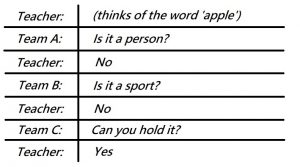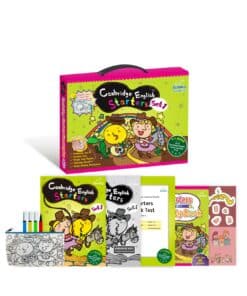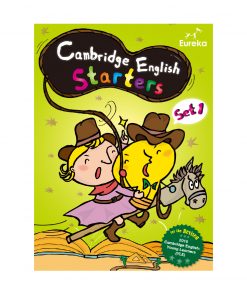Hangman
Materials: Board, Markers
Dynamic: Whole class or teams
Time: 10 – 15 minutes
Procedure:
1. Set a theme or topic for the words based on what has been taught (e.g. animals, sports, adjectives, nouns, verbs, etc.)
2. Think of a related vocabulary word that has been taught.
3. Write a dash for each letter on the board.
4. Students guess which letters are in the word.
5. Students take turns to call out a letter.
More difficult: You may suggest that students cannot choose a vowel.
6. If the letter is in the word, write it in the correct place(s) on the dashes. If the letter is not in the word, draw the first part of the hanged man on the board. Write the incorrect letter on one side of the board so students know which letters have already been
mentioned.
7. The game finishes when:
– the hangman drawing is complete like the picture on the right (students lose)
– or someone guesses the word (students win)
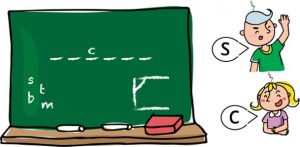

Jumbled Letters
Materials: Board, Markers
Dynamic: 3 – 4 groups
Time: 10 – 15 minutes
Procedure:
1. Set a theme or topic for the words based on what has been taught (e.g. animals, sports, adjectives, nouns, verbs, etc.)
2. Think of a related vocabulary word that has been taught.
3. Split class into 3-4 groups.
4. Write the word on the board but with letters spaced out and in a random order.
5. The group who can unjumble the letters to spell the word quickest wins a point.

Last Person Standing
Materials: Ball
Dynamic: 3 – 4 groups
Time: 15 – 20 minutes
Procedure:
1. Have students stand up in a circle or by their desks.
2. Name a topic (e.g. food, adjectives) and throw a ball to a student.
3. The student must then say a word or phrase relating to the category (set a time limit).
4. Then, they throw the ball to another student, who must do the same.
5. Change the topic after 8-10 throws.
6. Should a student repeat a word or fails to think of a word in the time limit, they must forfeit a leg, e.g. they have to stand on one leg.
7. If they get another wrong, then they have to sit out. Alternatively, they can just sit out after failing to guess a word first time round.
8. The last student standing wins the game.
A – Z Race
Materials: Board, Markers
Dynamic: 2 groups
Time: 15 – 20 minutes
Procedure:
1. Divide the class into two teams each standing in line at the board (one behind the other).
2. Give them a topic like food and drink, sports, adjectives, etc. (they must be very large lexical sets).
3. The student at the front on each line runs to the board and must write a word in this lexical set beginning with A on the board.
4. Make sure the two tables/charts on the board or on opposite sides so the players don’t do a sneaky peak of the other teams answers.
5. She then hands the chalk or pen to the next person in the row (and runs to the back of the line), who adds a word beginning with B until they reach Z.
6. If they cannot think of a word beginning with a particular letter they can leave a space, but the team with most words at the end is the winner.
7. Example of a board during a game: Topic: Verbs
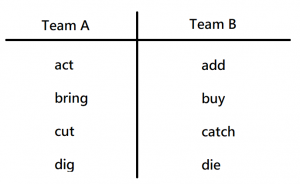
Categories
Materials: Paper
Dynamic: 3 – 4 groups
Time: 10 – 15 minutes
Procedure:
1. Very good as a mid-way vocabulary session or overall revision.
2. Have students draw six columns on their paper and write a category at the top of each column.
3. Choose categories that fit with what has been learnt so far or go over with some basics.
4. Choose a random letter and write it on the board.
5. Give students enough time to write down a word for each category that starts with that letter.
6. If they can’t think of a word, then they can leave it blank. However, the team with most correct answers win.
7. Repeat with new letters as many times as you like.
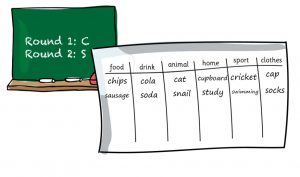
B-I-N-G-O
Materials: Bingo
Dynamic: Whole class
Time: 10 – 15 minutes
Preparation: Blank (or filled in) bingo cards for each student
Procedure:
- Give each student a blank B-I-N-G-O card.
- For less-abled students, you may have words prepared already on the BINGO cards, but make sure you have written them down yourself so you know which words to call out.
- Call out a word and have students to make them on their cards if they have the word themselves.
- The first person to finish marking their entire page wins.
- Alternatively, the first person to get 3 or 4 in a row (depending on size of grid), wins.

Variations:
- Picture
Use pictures on the BINGO cards. Call out the words that relate (nouns, verbs, adjectives).

- Synonym
Advanced: Say a word and students have to see if they have a word with a similar or same meaning to the one given by the teacher (adjectives).

- Antonym
Advanced: Say a word and students have to see if they have a word with the opposite meaning to the one given by the teacher (adjectives).

- Verbs
Have past simple, past participle or -ing forms of verbs on Card. Teachers shouts out a base form of a verb and students to match.

*You may use an online BINGO card generator to make your own cards if necessary, For example, https://myfreebingocards.com/
Sentence Race
Materials: Board, Markers
Dynamic: 2 teams
Time: 10 – 15 minutes
Procedure:
1. Tell students they will be competing to see which team is the first to complete a group sentence.
2. Next, divide the class into two teams. If the group contains an uneven number, one person may compete twice.
3. The teams then line up 10 feet from their board.
4. After giving the first person in each team’s line a piece of chalk or marker, explain the rules of the game.
5. The rules are: Each team member needs to add one word to the sentence. Players take turns. After they go to the board and write one word, they run back to give the next player the marker, and then go to the end of the line. (The sentence must contain the same number of words as there are members on the team.)
6. A player may not add a word between words that have already been written.
7. The winning group is the one with the most accurate sentence written in the shortest time.
8. Get students to try and make the most creative/funny sentence.
To make it more relevant to lesson, you may set the theme of the sentence or you may include a word or two that students must include in their group sentence.
Example: The theme is shopping and groups must include the words ‘clothes’ and ‘apple’.
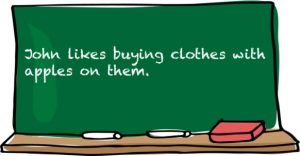
Word Chain
Materials: Board, Markers (optional if require visual help)
Dynamic: Whole class
Time: 10 – 15 minutes
Procedure:
1. Get students in a line.
2. Set the theme or topic for the game depending on what has been taught.
3. Say a related vocabulary word based on the topic.
4. Then, next person to you must say a related vocabulary word that begins with the last letter of the previous word.
5. See if the chain can continue to the end of the line.
Example: Topic – Food
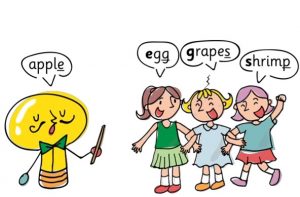
Pictionary
Materials: Board, Markers
Dynamic: 3 – 4 groups
Time: 15 – 20 minutes
Procedure:
1. Divide the students into 3 to 4 teams. Label them Team A to D (they can play rock, paper, scissors to see which team goes first).
2. Draw a small column for each team on one side of the board. You’ll record their points here.
3. Have one person from Team A come up to the front. Whisper or prepare a cue card with words/phrases to which they must draw.
4. The student must convey the word(s) to his or her team using only drawings.
5. Students cannot use words, symbols or hand gestures.
6. Each team gets a time limit of 3 minutes.
7. If a team struggles, they can say pass, but the other teams can guess (the other teams can play rock, paper, scissors to see who gets to answer first).
8. The team who guesses the most correct words wins.
Charades
Materials: Cue cards
Dynamic: Groups of 5
Time: 15 – 20 minutes
Preparation: Prepare cue cards with relevant words od phrases that has bee taught on each.
Procedure:
1. Split class into teams of 5. Each team takes turns to play.
2. One student from Team A comes up. Show them a cue card which they have to act/mime out to their team (they must not speak or say a word).
3. If it is a phrase, the ‘actor’ can demonstrate the number of words in the phrase by using their fingers, e.g. if the phrase has 3 words then they show three fingers at the start.
4. Each team has three minutes (or any amount of time you want to set) to try and guess the word/phrase being acted out.
5. See how many each team can get in the time limit.
Picture Dictation
Materials: Pictures ; Blank paper
Dynamic: Pairs
Time: 15 – 20 minutes
Preparation:
Prepare pictures of scenes (2 different pictures for each pair) which relate to what students have been studying, these can include:
- a map or a picture of a street (Focus: directions / placed in town)
- a supermarket scene, kitchen, things on shelves, etc. (Focus: food, quantities and containers)
- a scene of people doing things, at a sports centre, park, etc. (Focus: People, clothes, actions, etc.)
Procedure:
1. Divide class into pairs.
2. Arrange pairs so they are sat back to back.
3. In the pairs, one is Student A and one is Student B.
4. Give Student A, one scene picture. Give Student B, a blank piece of paper.
5. Student A describes their picture to Student B.
6. Student B tries to draw the picture according to the descriptions.
7. After they have finished, pairs should compare Student A’s picture and Student B’s drawing. Are they similar?
8. Now reverse it.
9. Give Student B a different picture, which they have to describe to Student A.
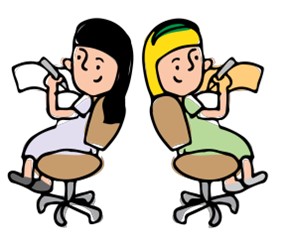
Word Twist
Materials: Scrap paper
Dynamic: Individuals or groups
Time: 10 – 15 minutes
Procedure:
1. Write a word on the board. This may be a newly-taught word for vocabulary consolidation or just a general word.
2. In teams or on their own, students have to come up with as many words as possible using all or some of the letters in the original word.
Example:
Original word: horse
Other word combinations: hose, rose, shoe, or, sore, hoe
3. Elicit answers by having students safely run to the board and write down all the possible letter combinations; or simply list out the words on a piece of scrap paper.
4. Repeat a few times. The student or team that comes up with the most words win.
5. Praise all for their efforts.
Guess the List
Materials: Blank paper
Dynamic: 4 groups
Time: 15 – 20 minutes
Procedure:
1. Split the class into 4 groups. Give each group a piece of paper.
2. Label each group from A to D.
3. Give each group a different theme/topic which is to be kept secret from the other teams.
4. Each team has 5 minutes in private to think of and write a list of ten items related to their specified topic.
5. After 5 minutes, get teams to put their pens down.
6. Tell Team A the name of Team B’s topic.
7. Team A then has one minute to guess the items on Team B’s list.
8. Team B should listen and tick the items wthat Team A guesses correctly.
9. For every word Team A guesses correctly, they score a point.
10. For every word they miss, Team B gets a point.
11. Record points on a table.
12. After one minute is up. Team A must stop talking.
13. Now, tell Team B the name of Team C’s topic.
14. Repeat points 7 to 12 with the new teams.
15. Repeat until each team has made guesses.
Round 1: Team A guesses Team B
Round 2: Team B guesses Team C
Round 3: Team C guesses Team D
Round 4: Team D guesses Team A
16. Tally up the points to see which team has the highest.
17. Praise all teams.
Example:
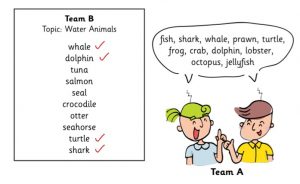
Taboo
Materials: PowerPoint (PPT)
Dynamic: Groups of 5
Time: 15 – 20 minutes
Procedure:
1. Split class into teams of 5. Each team takes turns to play.
2. Place a seat at the front of the class (back facing the board).
3. One student from Team A comes up and sits in the ‘hot seat’.
4. You will show his or her team mates one of the PPT slides with a word or phrase. The student in the hot seat will not be able to see the slides.
5. Each team has three minutes (or any amount of time you want to set) to get their hot seat member to say the word on the PPT.
6. The catch is, team members can’t say the word under any circumstances, but they may shout out other words relating to the word.
7. No actions or demonstrations are allowed either (that’s charades).
8. See how many each team can get in the time limit.
9. The words shown do not need to follow the order as in the PPT. You may choose the words at random.
More Difficult: For each word or phrase you may add additional words to which team mates cannot use to describe the word or phrase.
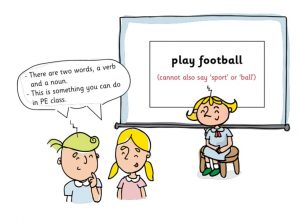
Yes/No
Materials: None
Dynamic: 2 – 3 groups
Time: 10 – 15 minutes
Procedure:
1. Split class into 2-3 groups.
2. Play Rock, Paper, Scissors to determine order.
3. The teacher has a word or phrase in mind. You may provide the theme if you wish.
4. Teams take it in turns to ask the teacher a yes/no question.
5. After so many questions, if a team thinks that they know what the word or phrase is, they must shout out a magic word (can pick any word you like).
6. Should a team get it wrong, then they are not allowed to guess the answer until another team has tried.
Example:
